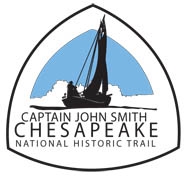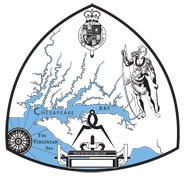

Come on a journey to remember and commemorate
the history and travels of Captain John
Smith!
Over four
hundred years ago, Englishman John Smith and a small crew set out
in an open boat to explore the Chesapeake Bay. Between 1607 and
1609 Smith mapped and documented nearly 3,000 miles of the Bay and
its rivers. Along the way he visited many thriving American Indians
communities and gathered information about this “fruitful and
delightsome land.” In December 2006 the U.S. Congress
designated the routes of Smith’s explorations of the
Chesapeake as a national historic trail—the first national
water trail.
Are you ready to follow in the wake
of Captain John Smith? Visit sites along the National Historic
Trail and learn about the native cultures and the natural
environment of the 17th-century Chesapeake through the Captain John
Smith Chesapeake Geotrail. The Trail provides opportunities for you
to experience the Bay through the routes and places associated with
Smith’s explorations. Caches will be located in museums,
refuges, parks, and towns in Virginia, Maryland and Delaware along
the rivers and creeks that Smith and his crew explored four
centuries ago.
The Captain
John Smith (CJS) Geotrail launched June 4, 2011 with over 40 caches
within Maryland, Virginia and Delaware. A trackable geo coin will
be awarded to the first 400 geocachers, while supplies last, for
locating at least 15 CJS caches. To be eligible for the coin,
geocachers must download a passport from either the CJS Geotrail or Maryland Geocaching Society website.
Geocachers must find and log at least 15 finds, record the code
word from each cache on their passport and post a picture of
themselve at each cache location. After discovering the 15 required
caches, geocachers may have thier passports validated in person or
via mail at the National Park Service, Chesapeake Bay Office
located at 410 Severn Ave, Suite 314, Annapolis, MD 21403. Please
refer to the passport for complete validation instructions.
Participating in the CJS geotrail is fun and we
hope that many people join in. However, it is not a requirement for
logging your find on this cache once you find the container.
You are seeking a tradional hide. Take the time to enjoy this
special
location.

John Smith and his crew marveled at the natural
abundance they encountered throughout their explorations of the
Chesapeake Bay and its tributaries. While it is unclear if they
explored as far as Reedville, if they had, they might have been
impressed by the abundance of menhaden, a small, oily fish whose
unimpressive appearance belies its importance. In the 17th century,
its main value was as a filter feeder - adult menhaden can rid four
to six gallons of water of algae in a minute.
The abundance of fish was an early and intense draw to English
colonists, and menhaden in particular were praised for their
delicate flavor, and their oiliness seen as a boon in that it
simplified cooking them – traits their American Indian
predecessors probably appreciated as well. Mehaden fishing
wasn’t fully commercialized until the late 19th century, when
Captain Elijiah Reed (the namesake of Reedville) opened the first
processing plant and brought to the established community of
watermen a method of extracting large quantities of oil from the
fish by rendering them by the millions. Their oil was used as a
lubricant and in lighting, as whale oil was, and the leftover bones
and carcasses were valuable as fertilizer. The industry boomed
through the early 20th century. The homes of these early menhaden
captain line Main Street in Reedville, many of them restored to
their original splendor. One of these is the Walker House, now the
home of the Reedville Fishermen’s Museum. The Museum also has
two additional properties on the National Register of Historic
Places that are very special in that they’re afloat! Visitors
can see two early 20th century menhaden fishing boats, the Claud W.
Somers and the Elva C, carefully restored by dedicated volunteers.
Today, menhaden fishing continues in Reedville’s surrounding
waters, and these unassuming little fish are the main sources of
omega-3 fatty acids used in human supplements.
 Thanks to Snailman22030 for helping with this hide and to the
Maryland Geocaching Society for assisting with this
project!
Thanks to Snailman22030 for helping with this hide and to the
Maryland Geocaching Society for assisting with this
project!